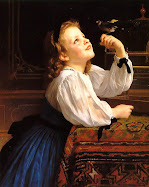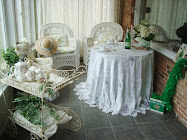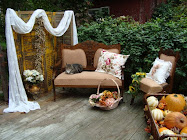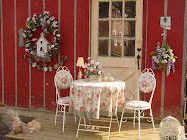In the Victorian era, a lady would welcome her guests in her sitting room. She would do her hand sewing, needlework and crafting in there. She would have tea with her guests and play games and gossip in there. It would be her sanctuary from the "men folk" and her husband could enter only by invitation.
It was almost always on the second floor, perhaps near her bedroom. Mine is near the guest room and could be used as a parlor for guests. Although there are only two of us that live in this big house, I find it very relaxing and comforting in this little room. I read in here a lot and have been known to take a winter nap or two on the chase after staring out the window at the frozen backyard gardens.
This began as a large room at the top of the stairs, perhaps a bedroom. I wanted a walk-in closet, just for me, so we took this room and split it in two. One side is this sitting room and the other side (I'll show you that later) is my closet/dressing room. Each room is about 12 x 12 feet.
Here are the before photos of the floor....



On the left in the first photo is the door to my closet. I'll post the after when we get all done in a few days.
Now, this floor is not in terrible shape, but it was hard to clean with the cracks opening up over the years. They were filled with some tar like substance that has dried out and flakes when you run the sweeper over it. Back in the day, they would have used "second grade" materials upstairs.
I'm not sure what type of wood this is, but it is soft and splinters easily. I know this flooring is at least 100 years old as it is nailed down with square headed nails that are hand forged and obviously made by a blacksmith. It was covered by carpet and heavy padding which I removed a year or so ago.
Between projects, I've been trying to clean and organize my sewing and craft rooms. Boy, what a mess! I have so many new ideas for my Victorian Era loving customers that my head is swimming and I'm really anxious to start working on some of these.
I need to get rid of a few of the cottage items in order to add new. You can help me here! Aunt May's Cottage will be having a HUGE clearance sale soon. Watch for the announcement here!
Have a safe and Happy New Year and come back to visit soon.
















